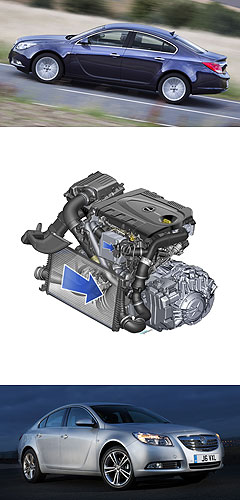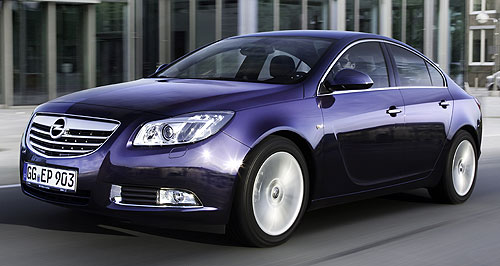Future models - Opel - Insignia - CDTi BiTurboOpel Insignia diesel goes biturboFrugal firebrand: The Opel Insignia diesel has been revitalised courtesy of a new BiTurbo engine co-developed with Saab. Punchy new sequential-turbo diesel fires up Open Insignia, thanks to Saab6 Dec 2011 WHILE ailing Saab might be about to breathe its last, the Swedish car-maker’s spirit will live on in a new diesel engine that is set to breathe new vigour into Opel’s Insignia – the European mid-sized car produced by General Motors, the company that placed Saab on death row in 2010. The new top-line version of the 2.0-litre CDTi BiTurbo four-cylinder engine packs 143kW of power and 400Nm – making it the most powerful diesel in the Insignia line-up by a margin of 25kW – while delivering super-frugal 4.9-litre per 100km fuel economy and 129 grams per kilometre CO2 emissions. This eclipses the fuel efficiency of thrifty mainstream 2.0-litre mid-size front-drive European diesel cars such as the Ford Mondeo (5.9L/100k and 157g/km) and Volkswagen Passat (5.7L/100km and 151g/km), as well as the current Mazda6 (5.9L/100 and 154g/km). However, the Insignia engine’s moment in the sun might be short-lived, as Mazda’s new Sky-D diesel engine technology promises fuel economy as low as 4.0L/100km and carbon emissions around 105g/km when it arrives in 2012. The Insignia is one of three models that will kick-off the Opel brand in Australia in 2012, joining the Corsa and Astra in local showrooms after an Australian International Motor Show debut.  Opel Australia has confirmed it will take a 2.0-litre diesel engine – which was co-developed with Saab – alongside a similar-sized direct-injection petrol powerplant. Opel Australia has confirmed it will take a 2.0-litre diesel engine – which was co-developed with Saab – alongside a similar-sized direct-injection petrol powerplant.But it has confirmed it will not take the latest hi-po biturbo diesel in its launch fleet, sticking with the standard 118kW turbo diesel, at least initially. Opel Australia marketing and public relations manager Michelle Lang told GoAuto today that the company would keep a lid on model variants in the start-up stages. She did not rule out the appearance of the engine in the Australian line-up, saying: "It looks like an absolute ripper, and we are interested in it."In Europe, the new flagship diesel – a development of the previous 118kW/350Nm CDTi engine – will be applied to both sedan and wagon models in both AWD and 2WD. Formally the province of prestige car-makers, biturbo sequential turbo-charging employs two turbochargers of different sizes that work either separately or together to cut turbo lag and lift peak charging. Opel says the smaller turbocharger accelerates especially quickly at low engine speeds, bringing on 350Nm of torque from just 1500rpm. Both turbos operate together in the mid range, with the larger turbocharger pre-compressing the intake air, before it is fully compressed in the smaller one. From about 3000rpm, all the gases flow directly to the larger turbo-charger for full boost. As well, the engine uses a world-first twin intercooler system – a water-cooled unit linked to the small turbo for low revs to give the inlet air a quick trip to the engine, and then bigger, conventional air-cooled intercooler to handle the bigger volumes of air from the large turbo. Opel Insignia chief engineer Volker Scharf said the engine produced power and torque at similar levels to a six-cylinder 3.0-litre diesel engine. “With our biturbo technology, smaller engines produce even more output while enabling 30 per cent lower fuel consumption and emissions,” he said. “This is a very good example of successful downsizing by Opel.” The new engine is said to be good for a 0-100km/h sprint in 8.7 secondsManual Insignias get idle-stop, helping to trip the fuel consumption that Opel claims is just 4.9L/100km for the most efficient model, the front-drive sedan. No figures are given for the 4x4 and wagon models.  Read moreAll future models Alfa Romeo Alfa Romeo Abarth Abarth Audi Audi Aston Martin Aston Martin BMW BMW Bentley Bentley Chrysler Chrysler Chevrolet Chevrolet Dodge Dodge Citroen Citroen Ferrari Ferrari DS DS Ford Ford Fiat Fiat FPV FPV Foton Foton Haval Haval Great Wall Great Wall Honda Honda Holden Holden Hyundai Hyundai HSV HSV Isuzu Isuzu Infiniti Infiniti Jeep Jeep Jaguar Jaguar Lamborghini Lamborghini Kia Kia Lexus Lexus Land Rover Land Rover Mazda Mazda Maserati Maserati Mercedes-Benz Mercedes-Benz McLaren McLaren Mini Mini Nissan Nissan Mitsubishi Mitsubishi Peugeot Peugeot Opel Opel Proton Proton Porsche Porsche Renault Renault Ram Ram Saab Saab Rolls-Royce Rolls-Royce Smart Smart Skoda Skoda Subaru Subaru SsangYong SsangYong Tesla Tesla Suzuki Suzuki Toyota Toyota Volvo VolvoMotor industry news |
Click to shareOpel modelsResearch Opel All future models Alfa Romeo Alfa Romeo Abarth Abarth Audi Audi Aston Martin Aston Martin BMW BMW Bentley Bentley Chrysler Chrysler Chevrolet Chevrolet Dodge Dodge Citroen Citroen Ferrari Ferrari DS DS Ford Ford Fiat Fiat FPV FPV Foton Foton Haval Haval Great Wall Great Wall Honda Honda Holden Holden Hyundai Hyundai HSV HSV Isuzu Isuzu Infiniti Infiniti Jeep Jeep Jaguar Jaguar Lamborghini Lamborghini Kia Kia Lexus Lexus Land Rover Land Rover Mazda Mazda Maserati Maserati Mercedes-Benz Mercedes-Benz McLaren McLaren Mini Mini Nissan Nissan Mitsubishi Mitsubishi Peugeot Peugeot Opel Opel Proton Proton Porsche Porsche Renault Renault Ram Ram Saab Saab Rolls-Royce Rolls-Royce Smart Smart Skoda Skoda Subaru Subaru SsangYong SsangYong Tesla Tesla Suzuki Suzuki Toyota Toyota Volvo VolvoMotor industry news |















Facebook Twitter Instagram